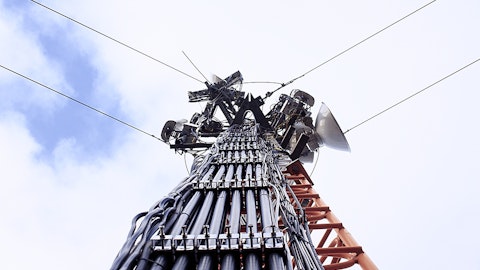Lumentum Holdings Inc. (NASDAQ:LITE) Q2 2024 Earnings Call Transcript February 8, 2024
Lumentum Holdings Inc. beats earnings expectations. Reported EPS is $0.32, expectations were $0.31. Lumentum Holdings Inc. isn’t one of the 30 most popular stocks among hedge funds at the end of the third quarter (see the details here).
Operator: Good day, everyone, and welcome to the Lumentum Holdings’ Second Quarter Fiscal Year 2024 Earnings Call. All participants will be in a listen-only mode. Please also note that today’s event is being recorded for replay purposes. [Operator Instructions] At this time, I would like to turn the call over to Kathy Ta, Vice President of Investor Relations. Ms. Ta, please go ahead.
Kathy Ta: This is Kathy Ta, Lumentum’s Vice President of Investor Relations. Joining me today are Alan Lowe, President and Chief Executive Officer; Wajid Ali, Executive Vice President and Chief Financial Officer; and Chris Coldren, Senior Vice President and Chief Strategy and Corporate Development Officer. Today’s call will include forward-looking statements, including statements regarding our expectations and beliefs regarding recent acquisitions, including Cloud Light and NeoPhotonics, financial and operating results, macroeconomic trends, trends and expectations for our products and technology, our end markets, market opportunities and customers, and our expected financial performance, including our guidance as well as statements regarding our future revenues, financial model, and margin targets.
These statements are subject to risks and uncertainties that could cause actual results to differ materially from our current expectations, particularly the risk factors described in our SEC filings. We encourage you to review our most recent filings with the SEC, particularly the risk factors described in the 10-K for the fiscal year ended July 1, 2023, and our 10-Q that will be filed soon. The forward-looking statements provided during this call are based on Lumentum’s reasonable beliefs and expectations as of today. Lumentum undertakes no obligation to update these statements, except as required by applicable law. Please also note that unless otherwise stated, all financial results and projections discussed in this call are non-GAAP. Non-GAAP financials are not to be considered as a substitute for or superior to financials prepared in accordance with GAAP.
Lumentum’s press release with the fiscal second quarter results and accompanying supplemental slides are available on our Web site at www.lumentum.com under the Investors section. With that, I’ll turn the call over to Alan.
Alan Lowe: Thank you, Kathy, and good morning, everyone. Lumentum stands at the leading edge of photonics innovation, partnering with customers to enable the future of data centers and the networks that connection them. We equip our customers with the industry’s most comprehensive photonics portfolio, enabling them to unlock unparalleled performance and efficiency. From pluggable high-speed transceivers to enabling customers AI-optimized architectures with industry-leading transmitters and photonics, we are at the forefront of data centers’ needs. Together with our cloud customers, we are shaping the future of data transmission through pioneering technologies such as chip-scale photonics and advanced data transmission protocols, as well as highly efficient and automated manufacturing at scale.
It has been just three months since we acquired Cloud Light, and we are thrilled with the team that has joined us and the many opportunities that lie ahead. In this brief period, we have had meaningful traction with customers on new data center opportunities which we expect will drive significant additional growth as we complete the development of the new products and receive customer qualifications. The market opportunity is accelerating, and we expect broader customer adoption of 800G technology as these qualifications finalize. Additionally, the initial ramp-up of 1.6 terabit products by early technology adopters is creating a lot of pull from customers. And we expect to have a first-to-market advantage given our vertical integration and test results from our labs.
Cloud Light transceiver shipments were very strong in the December quarter, contributing $59.5 million during the approximately eight weeks after the acquisition. We expect our shipments will be even stronger in the March quarter. Given a mid-calendar-year product transition planned by our largest data center customer, we expect revenue from data center transceivers to temporarily dip in the June and September quarters, and then grow significantly through the end of the year and into calendar year ’25, as this transition completes and other new customer programs start to ramp. Given the surging data demands of AI data centers and our strong traction on new transceiver opportunities, we are strategically expanding our leading-edge transceiver manufacturing capacity.
As a key part of this expansion, we are investing in state-of-the-art production lines at our manufacturing facility in Thailand. Our Thai factor has proven photonics manufacturing capabilities, and has received numerous customer accolades, giving us confidence in our ability to ramp rapidly. This capacity will come online this summer, and we expect to lead the first wave of 1.6 terabit transceivers from multiple customers at this site. In addition to this new capacity expansion in Thailand, we will be leveraging Lumentum’s components in new Cloud Light transceiver designs. We believe the combination of our established history of customer partnership, proven manufacturing leadership, and unrivaled breadth of differentiated photonic component capabilities puts us at an excellent position to accelerate top line revenue growth and margins in this rapidly growing cloud transceiver market.
While cloud data centers are forecasting double-digit CapEx growth in calendar ’24, we are navigating challenging market conditions in other parts of our business. Based on sluggish carrier CapEx spending and our latest customer discussions, we now expect customer inventory digestion to extend through the balance of fiscal ’24. Nevertheless, we are highly confident in our market position and the ultimate recovery and growth of this business. As fiber transmission reaches its physical capacity, network providers increasingly recognize the value of technologies, like ours, that enable continued network scaling, reinforcing our long-term confidence in this business. Moving to our Industrial Tech segment, we are very excited about our traction on new products serving new applications, particularly for our ultrafast lasers.
These are ramping up and are adding to our customer end market diversification in our Industrial Tech segment. That said, we do expect a period of lower demand over the coming quarters driven by typical seasonality in our consumer business and by macro softness in the industrial market, along with elevated customer inventory levels at one of our large laser customers. We expect the industrial laser inventory to be corrected over the next six months, around the same timeframe as the seasonal uptick in our consumer business. This, combined with our wins at new customers in new markets, should lead to an Industrial Tech segment recovery during second-half of the calendar year. Moving on to fiscal second quarter results, second quarter revenue and EPS results were above the midpoints of our guidance ranges, with revenue of $366.8 million and EPS of $0.32.
I’m very excited about the contribution that our Cloud Light acquisition had on the quarter, and will have in the future given the technology and capability of the combined companies to address the rapidly growing AI and ML photonics market. We have continued to drive acquisition synergies to drive down our fixed costs, and Wajid will provide more color on this shortly. The combination of these lower fixed costs and the rebound in revenue will result in an accelerated expansion in our margins during fiscal ’25. Cloud & Networking revenue was up 25% sequentially driven by strong cloud data center demand and the contribution from the Cloud Light acquisition, but down 25% year-on-year given broad-based softness across most of our telecom networking product lines due to the continued inventory correction at our network equipment customers.
The future is bright for our cloud technology roadmap. In the second-half of calendar ’24, we expect to qualify the industry’s first power-efficient 800G transceivers that employ 4×200 gig lanes of traffic using silicon photonics technologies. As I mentioned earlier, we expect to ramp capacity this summer at our campus in Thailand, and expect to lead the first wave of 1.6 terabit transceivers for multiples customers in this facility. These ultrahigh-speed transceivers provide additional bandwidth needed for AI workloads, while also alleviating data bottlenecks with lower power consumption and latency as customers move to 200-gig-per-lane technology. We expect that 200-gig-per-lane optics, using not only silicon photonics technology, but also our vertically integrated EML lasers will be the workhorse of the next generation of hyperscale data centers once these new products are qualified at leading cloud and cloud infrastructure customers.
We have been receiving positive customer feedback about our 100-gig VCSEL performance for short-distance data center applications. And expect to start ramping production in the second-half of calendar ’24. We will qualify our VCSELs in Cloud Light’s active optical cables and transceiver platforms in the coming quarters. We are also working closely with cloud infrastructure providers on novel components and modules that leverage our unique technology capability to enable new future AI hardware architectures for higher-bandwidth lower power density and low-latency optical interconnects essential for training in inference applications. With the rapid build-out of AI and ML data centers, connecting those data centers with high-speed power and cost-efficient interconnects is becoming even more important.

To that end, we continue to have success in our 400-gig ZR module business where, in Q2, we grew over 30% sequentially. Additionally, we are receiving positive customer feedback on our 800G ZR modules. And, we are on-track to be first to market with customer samples this year. These modules will enable even higher speed extended reach data center interconnects to help keep space with rapidly expanding data center infrastructure. Our coherent transmission products outside of the data center are receiving positive customer feedback and transaction on our next generation 130 and 200 gigabaud data rate technologies that enable next generation coherent applications at 800G, 1.2G, and 1.6G. These high speed products are available in both the suite and integrated form factors to enable enhanced performance in next generation metro and long haul applications.
As we move through calendar ’24, we believe we are at the forefront of 200 gigabaud optical technology with our first-to-market and first-to-volume products. Turning to Industrial Tech. Fiscal Q2 was down 9% sequentially as expected, driven by seasonality in our 3D sensing business and inventory consumption at one of our large industrial lasers customers. Industrial Tech was down 35% year over year, primarily due to increased competition for market share on a certain 3D sensing socket that we have discussed previously and overall macroeconomic softness. We expect revenue of 3D sensing for consumer applications to contribute approximately 5% or less of company revenue in Q3 and Q4 of fiscal ’24. As the shift industry 4.0 and 5.0 drives demand for greater automation and precision manufacturing, our laser products are well-positioned to address evolving industrial needs.
With precise control and pulse parameters in quality and stability, we are seeing growing opportunities for our ultrafast and solid state lasers across key micromachining applications in semiconductor, EV batteries, displays, PCBs, and solar cell manufacturing. Growth in new micromachining applications will help to partially offset the near-term headwinds I mentioned earlier. To summarize, high speed data center demand is skyrocketing. And, we are accelerating product development and production to capture this growth. Armed with longstanding customer partnerships, industry leading manufacturing, and an unmatched portfolio of advanced photonic components, we are positioned to market share in the surging cloud transceiver market, driving significant top line and margin growth for Lumentum.
Before turning it over to Wajid, I would like to thank our employees and our customers around the world for their focus and dedication as they continue to collaborate and partner with Lumentum. With that, Wajid?
Wajid Ali: Thank you, Alan. As Alan mentioned, we are confident about our market position and growth opportunities across our surge markets. We are focused on lowering our fixed cost base so that as the revenue recovers, operating margin dollars will expand faster than revenue. To this end, we have made significant progress on manufacturing synergizes by hitting key milestones on closing two new photonic factories in China this past December. The benefit will accrue to our financial position as we ramp production of most of those products at our Thailand facility. Additionally, our Japan wafer fab consolidation plans are progressing well. And, we expect to execute this plan by the first-half of fiscal ’25, allowing us to attain significant additional synergies in both manufacturing and operating expenses beginning in the fiscal third quarter of 2025.
As well, we continue to see incremental synergy and efficiency opportunities within our operating expenses. Consequently, we are increasing our synergy attainment expectations to $100 million, up from the prior target of $80 million. To date, we have achieved approximately $60 million in annual run-rate savings and expect to achieve the remaining $40 million as we execute against our plan. We will provide you with further updates as we achieve critical milestones. As I have mentioned previously, we had pre-built inventory of NeoPhotonics products to enable these factory transitions. In Q2, we reduced Lumentum’s overall inventory levels by approximately $20 million sequentially, excluding the increase in inventory related to Cloud Light. In addition, despite incorporating the operational expenses of our recent acquisition of Cloud Light in Q2, our tight financial discipline drove company-wide operating expenses down by $4 million on a year-over-year basis.
We’re confident that our combined efforts on manufacturing efficiency, inventory management, and cost control will pave the way for continued improvements in gross and operating margins as telecom revenue recovers and our cloud revenue continues to grow. Net revenue for the second quarter was $366.8 million, which was up 15.5% sequentially and down 27.5% year-on-year. As Alan mentioned, during the quarter, we recognized $59.5 million in revenue from a partial quarter of Cloud Light. The majority of this revenue came from 800G transceiver shipments. GAAP gross margin for the second quarter was 17.4%. GAAP operating loss was 28.7% and GAAP diluted net loss per share was $1.47 with a large portion of the GAAP net loss due to acquisition related charges and amortization.
Second quarter non-GAAP gross margin was 32.6%, which was down sequentially, and down year-on-year driven by product mix and factory underutilization. Second quarter non-GAAP operating margin was 3.5%, which was up sequentially and down year-on-year. Second quarter non-GAAP operating income was $13 million, and adjusted EBITDA was $39 million. Second quarter non-GAAP operating expenses totaled $106.7 million or 29.1% of revenue, up $6.6 million from Q1, due in part to the acquisition of Cloud Light and down $3.6 million from the year-ago quarter due to tight expense controls and continued synergy attainment. Q2 non-GAAP SG&A expense was $38.4 million. Non-GAAP R&D expense was $68.3 million. Interest and other income was $12.3 million on a non-GAAP basis due to interest earned on our cash and investments.
Second quarter non-GAAP net income was $21.7 million and non-GAAP diluted net income per share was $0.32. Our fully diluted share count for the second quarter was 67.4 million shares on a non-GAAP basis. Our cash position decreased by $720 million during the quarter, to $1.22 billion, this was primarily due to the $705 million in cash used for the purchase of Cloud Light. In addition, we incurred approximately $8 million of normal course expenses associated with the transaction. Turning to segment details, second quarter cloud and networking segment revenue at $286.7 million increased 24.8% sequentially and was down 25.1% year-on-year. Cloud and networking segment non-GAAP reporting profit at 10.1% decreased sequentially and year-on-year. Our second quarter industrial tech segment revenue at $80.1 million was down 8.9% sequentially and down 34.9% year-on-year.
Second quarter industrial tech non-GAAP reporting profit of 15.9% was down sequentially and year-on-year. Before I move to our guidance, I would like to add some context to an impact to our revenue related to export regulations. Late last year, we were notified by certain critical IC suppliers that service the industry broadly that their products do not comply with the latest export regulations. Consequently, in December, we stopped the majority of our product shipments to the largest networking equipment manufacturer in China. Our assumption is that these export regulations will continue indefinitely, and result in an approximately $40 million to $50 million reduction in calendar year ’24 revenue from our prior expectations. Longer-term, we believe geopolitical factors could pose a benefit to our revenue opportunity given our larger product footprint within other customers who are expected to be end-market share-gainers over time.
Now, let me move to our guidance for the third quarter of fiscal ’24, which is on a non-GAAP basis, and is based on our assumptions as of today. We expect net revenue for the third quarter of fiscal ’24 to be in the range of $350 million to $380 million. This Q3 revenue forecast includes the following assumptions. Cloud and networking to be up driven by strong cloud demand and a full quarter of Cloud Light despite more than a $10 million impact from the export regulations just mentioned, and Industrial Tech to be down nearly $40 million sequentially at the midpoint due to 3D-sensing seasonality and share dynamics, as well as industrial laser customer inventory digestion that Alan mentioned earlier. Based on this, we project third quarter non-GAAP operating margin to be in the range of 2% to 5%, and diluted net income per share to be in the range of $0.20 to $0.35.
Our non-GAAP EPS guidance for the third quarter is based on a non-GAAP annual effective tax rate of 14.5%. These projections also assume an approximate share count of 67.8 million shares. With that, I’ll turn the call back to Kathy to start the Q&A session. Kathy?
Kathy Ta: Thank you, Wajid. Before we start the Q&A session, I would like to ask everyone to keep to one question and one follow-up, this should us get to as many participants as possible before the end of our allotted time. Now, let’s begin the Q&A session.
See also 25 Least Family-Oriented Countries in the World and 15 Blue-Collar Jobs That Pay at Least $75,000 a Year.
Q&A Session
Follow Lumentum Holdings Inc. (NASDAQ:LITE)
Follow Lumentum Holdings Inc. (NASDAQ:LITE)
Operator: We will now start today’s Q&A portion of the call. [Operator Instructions] Our first question today comes from Simon Leopold from Raymond James. Your line is now open. Please go ahead.
Simon Leopold: Thank you very much for taking the question. I will try to keep to that one. So, I just wonder if you could maybe talk a little bit about your customer mix, customer concentration in this quarter. I’m wondering if you did have a new 10% customer, and how you see that particular concentration changing or evolving, both sequentially and then longer-term? And then I’ve got a quick follow-up.
Alan Lowe: Yes, thanks, Simon. Yes, we did have a new 10% customer primarily due to the Cloud Light addition to revenue to that customer. And I’d say that, as we talked about on the script, we expect that diversification around our transceiver business will grow rapidly towards the end of this calendar year and into ’25 as new 800-gig and 1.6T products are qualified with other hyperscalers as well as AI infrastructure companies. So, we’re very excited about that and the diversification of the customers around our transceiver business. I would say that one of the things we did talk about was the less dependency on our consumer business, and that’s why we gave specifics around 5% or less of our revenue in the next few quarters. And I think that’s a healthy place to be with, with our consumer business. Does that answer your question, Simon?
Simon Leopold: Thanks. And then, — it does. And you sort of teed up my follow-up nicely, in that, in the deck, the footnote mentions that Industrial Tech is expected to decline approximately $40 million sequentially. And I’m still sort of adjusting to this new segmentation. And I’m just wondering that implies 3D is essentially dropping to zero. I know you said less than 5%, but zero is also less than 5% or whether there’s a significant portion of that $40 million coming out of this inventory adjustment product cycle angle on your industrial lasers, so just looking for a little bit more help how to split that $40 million. Thank you.
Alan Lowe: Yes, I would say that we’re pretty confident in that 5-ish percent for consumer in Q3, so the balance would come from, we mentioned on the call, around the inventory reduction efforts by one of our largest laser customers. So, that’s how you could kind of split up that $40 million.
Simon Leopold: Thank you.
Alan Lowe: Thanks, Simon.
Kathy Ta: Thank you, Simon.
Operator: Our next question comes from Alex Henderson from Needham. Your line is now open.
Alex Henderson: Great, thanks. I wanted to dig into the Cloud Light business a little bit and understand some of the dynamics there. But I also wanted to understand whether Cloud Light’s technology in selling transceivers has changed the dynamics around your chip sales to other transceiver companies at all. First question, is the 800-gig products that you were talking about ramping on in VCSELs, is there a 1.6 terabit product coming down the pike for that, because we’ve just heard from Fabrinet that they’re expecting some impact on their business because of a product transition. I would assume that that is in the AOC segment because they don’t really do much in the InfiniBand segment. And I’m not aware of anybody having a 200-gig VCSEL product to ramp. So, can you talk about whether that technology is out there, and whether that’s something that’s in your cards on the AOC side?
Alan Lowe: Yes. Let me address your first question first, which is around the dynamics of our chip sales. And I would say certainly our chip customers had some concern around us being a competitor, but we assured them that we are their partners, and we really treat those two businesses very separately, with a wall between our chip development team and our transceiver team, so there’s no cross-contamination or concerns. And I think we’ve alleviated a lot of those concerns to the point where I am sold out on Datacom chips today, and through next quarter, and we’re adding capacity to meet the demands of our EML business, and bringing up our CW laser business in a rapid way. On the VCSELs, we talked about the 100-gig VCSELs being released in the second-half of this year, very positive results, just going through final qualifications.
And that would be more of an 800-gig AOC or 800-gig SR multimode transceiver. As far as 200-gig VCSELs, that’s a little bit out for us, and I think for the industry. So, 1.6T would be more of a silicon photonics or EML-based transceiver. But I’ll let Chris talk a little bit more about his thoughts on 200-gig VCSELs or 1.6T. Chris?
Chris Coldren: Yes, I mean, as you alluded to, Alan, we are focused — initial products of 1.6 terabit will be silicon photonic based. The industry is however developing 200-gig VCSELs on our roadmap, developing other third-party suppliers developing 200-gig VCSELs. So, those will feather in over time as well. And the Cloud Light transceiver platform has multimode transceiver, single-mode transceivers, so we’re well-positioned to participate in both opportunities.
Alex Henderson: So just that I understand, then if there is a 1.6 terabit product coming in the June quarter, it would have to be 16 lanes of 100, because I mean there is clearly an implication that there’s something of that sort coming down the pike in the June quarter, and by other peoples’ commentary. Is that not true?
Chris Coldren: I can comment on what our plans are, which involve silicon photonics-based approaches. I think we also have alluded to on the call that 200-gig-per-lane technology is also on the horizon, let’s say, and will coming out over the next year. So, I think you can put those facts together.
Alex Henderson: Okay, thanks.
Alan Lowe: Yes, but just to be clear, we have 1.6 terabit silicon photonics in our labs today. And we have 200-gig EMLs that we have qualified internally that are ready to go, and waiting for both internal qualification at the transceiver level as well as our customer’s transceivers qualifications using 200G EMLs that I think will come out later this year.
Q – Alex Henderson: Just for clarification, that would then be InfiniBand-related product, not AOCs, right?
A – Alan Lowe: Well, it would be either Ethernet or InfiniBand. How ever our customers use our Datacom chips is really up to them. And, we’re kind — we don’t really care whether it’s InfiniBand or otherwise. So, Chris, do you have any other comments on InfiniBand? Yes. Okay, Thanks.
A – Chris Coldren:
.:
Operator: Our next question today comes from Samik Chatterjee from J.P. Morgan. Your line is now open. Please go ahead.
Q – Samik Chatterjee: Hey, guys, thanks for taking my question. Maybe just not to sort of keeping going on Datacom, but to just make sure I am not confused. You talked about the product transition that your primary customer there for Cloud Light is undergoing. Maybe you can flesh that out a bit in your own words what’s the transition? And more curious to hear what’s your visibility in terms of market share with the customer following that transition? Any thoughts or any color on whether you expect any changes in relation to market share? And then, I have a quick follow-up. Thank you.
A – Alan Lowe: Yes, I’ll comment on product transition. Certainly, we have to be a little careful of customer sensitivity. But you can imagine that as 800G is launched, there are subsequent generations of 800G whether that be different form factor or transitioning from 100G to 200G per lane. So, there are range of changes as you get further into technology maturity to reduce power consumption and power density challenges in your systems. I think with regard to market share, we are very excited and believe that we have lots of opportunity to gain share. And, that’s why as we talked about in our prepared remarks that we are expanding capacity very significantly so that we can come out and really accelerate growth later this calendar year and into calendar ’25.
Q – Samik Chatterjee: Okay, got it. Thanks for that. And, maybe just for my follow-up. On the telecom segment, your primary competitor of your company is calling out a recovery in demand in China, which I am assuming you are not able to capitalize on because of the trade regulations. But, just curious if that this is a situation where you would sort just go rework the product and get through some of the supply chain reorganization to still try to address that market with a different customer? Or is this sort of an area where you really don’t have an option to go around and capitalize on that demand recovery in the China market? Thank you.
A – Alan Lowe: Yes, Samik. There are deployments about to happen in China that we are part of through non-Huawei customers. And, where in meaningful way very large part of the share non- Huawei in China network equipment manufacturers and things like that, so that’s one of the areas of strong string. We stopped shipping due to the need to follow regulations obviously. And I think that will trickle down eventually to the point where share will shift from network equipment manufacturers that we have a higher share of wallet on that over the long term we believe will be a tailwind for us.





